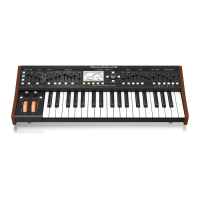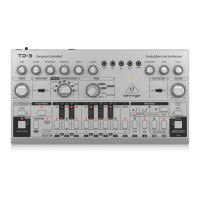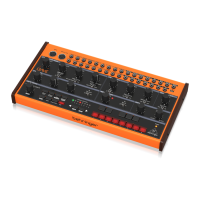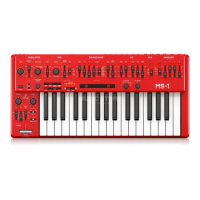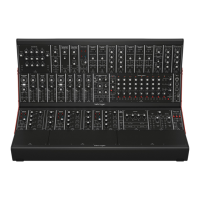22 DeepMind 12 User Manual
7. 2 FX (Eects Menu)
The on-board virtual FX Rack provides access to four true-stereo, multi-eects
processors including delay, chorus, dynamics and production-quality true-stereo
reverbs. You can select any combination of high-end simulations of legendary
studio eects.
Note: For detailed information on all eects and their parameters, please consult
the EFFECTS LIBRARY section later in this document.
7.2 .1 FX OVERVIEW
1. To access the FX menu press the FX switch: the FX switch will be illuminated
when you are in this menu.
2. The display will then show the FX OVERVIEW menu:
3. To navigate within the items in the FX OVERVIEW menu, use the BANK/UP,
BANK/DOWN, +/YES, and -/NO switches.
4. Selected parameters on the display are adjusted using the rotary knob or
the DATA ENTRY fader. The rotary knob has a click which allows very accurate
control. The fader allows rapid adjustment across the full range.
5. The options available in the FX OVERVIEW menu are as follows:
• FX ROUTING - At the top of the FX OVERVIEW menu, the FX ROUTING is
shown as a series of 4 boxes representing the individual eects.
In order to expand the sonic possibilities of the DSP FX inside the
DeepMind 12, there are 10 routing options for the four slots.
• FX MODE - This allows you to choose if the eects are to be congured
in INSERT MODE, SEND (and Return) MODE, or to BYPASS the eects.
• FX SLOTS - These are the four slots you can load eects modules into.
• MIX - The MIX parameter controls how much of the original sound is
blended with the eected/processed sound for each FX slot.
• LEVEL - The LEVEL parameter controls the output level of any eects
which are congured in parallel, or any eects which are the last eect
before reaching the output stage.
6. To exit the FX menu, press the PROG switch to return to the main
programming screen.
WARNING: The routings with feedback are highly creative, but as they employ
feedback loops, careful consideration should be made while using them. It is
recommended to keep the VOLUME knob in a low position while experimenting.
Note: To reduce the possibility of excessive low frequency build up, there is
a 30 Hz High Pass Filter used in the feedback path for routing options which
include feedback.
7.2.2 SELECTING FX ROUTING
1. To select a routing from the 10 dierent options, make sure that the '<'
symbol is highlighted next to the routing diagram, then you can either
turn the rotary knob, or use the data entry fader to select from one of the
following routings:
SERIAL 1-2-3-4 (M-1)
PARALLEL 1/2 SERIAL 3-4 (M-2)
PARALLEL 1/2 PARALLEL 3/4 (M-3)
PARALLEL 1/2/3/4 (M-4)
PARALLEL 1/2/3 SERIAL 4 (M-5)
SERIAL 1-2 PARALLEL 3/4 (M-6)
SERIAL 1 PARALLEL 2/3/4 (M-7)
PARALLEL (SERIAL 1-2-3)/4 (M-8)
SERIAL 3-4 FEEDBACK4(1-2) (M-9)
SERIAL 4 FEEDBACK4(1-2-3) (M-10)
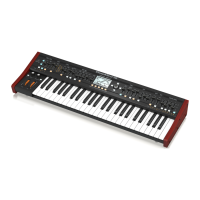
